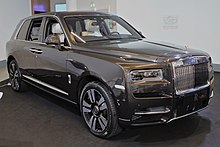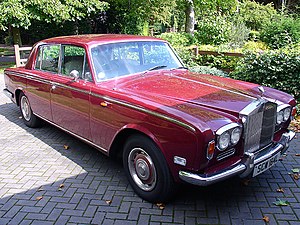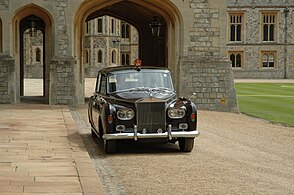ROLLS ROYCE
Rolls-Royce Limited
was a British luxury car and later an aero-engine manufacturing business established in 1904 in Manchester by the partnership of Charles Rolls and Henry Royce. Building on Royce's good reputation established with his cranes, they quickly developed a reputation for superior engineering by manufacturing the "best car in the world". The business was incorporated as "Rolls-Royce Limited" in 1906, and a new factory in Derby was opened in 1908. The First World War brought the company into manufacturing aero-engines. Joint development of jet engines began in 1940, and they entered production in 1944.[1] Rolls-Royce has since built an enduring reputation for the development and manufacturing of engines for military and commercial aircraft.
In the late 1960s, Rolls-Royce was adversely affected by the mismanaged development of its advanced RB211 jet engine and consequent cost over-runs, though it ultimately proved a great success. In 1971, the owners were obliged to liquidate their business. The useful portions were bought by a new government-owned company named "Rolls-Royce (1971) Limited", which continued the core business but sold the holdings in British Aircraft Corporation (BAC) almost immediately and transferred ownership of the profitable but now financially insignificant car division to Rolls-Royce Motors Holdings Limited, which it sold to Vickers in 1980. Rolls-Royce obtained consent to drop the '1971' distinction from its company name in 1977, at which point it became known once again as "Rolls-Royce Limited".
The Rolls-Royce business remained nationalised until 1987 when, after having renamed the company to "Rolls-Royce plc", the British government sold it to the public in a share offering. Rolls-Royce plc still owns and operates Rolls-Royce's principal business, although, since 2003, it is technically a subsidiary of Rolls-Royce Holdings plc, a listed holding company.
Motor cars
Henry Royce started an electrical and mechanical business in 1884. He made his first car, a two-cylinder Royce 10, in his Manchester factory in 1904. Henry Royce was introduced to Charles Rolls at the Midland Hotel, Manchester on 4 May of that year. Rolls was proprietor of an early motor car dealership, C.S. Rolls & Co. in Fulham.
In spite of his preference for three- or four-cylinder cars, Rolls was impressed with the Royce 10, and in a subsequent agreement on 23 December 1904 agreed to take all the cars Royce could make. There would be four models:
- a 10 hp (7.5 kW), two-cylinder model selling at £395, about £50,000 in 2021
- a 15 hp (11 kW) three-cylinder model selling at £500, about £60,000 in 2021
- a 20 hp (15 kW) four-cylinder model selling at £650,about £70,000 in 2021
- a 30 hp (22 kW) six-cylinder model selling at £890, about £100,000 in 2021
All would be badged as Rolls-Royces and be sold exclusively by Rolls. The first Rolls-Royce car, the Rolls-Royce 10 hp, was unveiled at the Paris Salon in December 1904.
Spirit of Ecstasy
Sculpture by Charles Robinson Syke
The Spirit of Ecstasy Sculpture is a bonnet mascot of the Rolls-Royce cars. It is in the form of a woman leaning forwards with her arms outstretched behind and above her. Billowing cloth runs from her arms to her back, resembling wings.
The Whisper, precursor to the Spirit of Ecstasy[edit]
The first Rolls-Royce motorcars did not feature radiator mascots; they simply carried the Rolls-Royce emblem. When John, 2nd Baron Montagu commissioned his friend, sculptor Charles Robinson Sykes, who worked in London under the nobleman's patronage, to sculpt a personal mascot for the bonnet of his 1909 Rolls-Royce Silver Ghost, Sykes chose Eleanor Velasco Thornton as his model. Sykes originally crafted a figurine of her in fluttering robes, having placed one forefinger against her lips – to symbolize the secret of the love affair between Thornton and Montagu.[1] The figurine was consequently named The Whisper and is on display at the National Motor Museum in Beaulieu along with other Spirit of Ecstasy figurines.
Only three or four castings were ever made, and only two are believed to have survived.
Phantom

- Rolls-Royce unveiled a new Phantom at "The Great Eight Phantoms Exhibit", which would go into production at the end of 2017, with sales starting in 2018. This is the current Flagship Model and the most expensive production car made by Rolls-Royce Motor Cars.
- A facelifted model, dubbed the Series II was revealed on May 12 2022 has received subtle exterior changes & 4 additional wheel options.
- The Phantom comes in 2 lengths, a standard version & an Extended Wheelbase version which added 200mm of length, solely for the rear passengers. The latter currently being the longest sedan currently in production.
Ghost (Second Generation)

- The Current Rolls-Royce Ghost was unveiled on 1 September 2020 as an Rolls-Royce's current Entry Model.
- An Extended Wheelbase version is available, adding 160mm of length into the car for the rear occupants.
Cullinan

- After much anticipation, Rolls-Royce revealed the Cullinan in early 2018. The 5-door SUV shares the "Architecture of Luxury" platform and many components with the Phantom.
Spectre

- Rolls-Royce's first all-electric car, and the most aerodynamic, the Spectre coupé[14] was revealed on 18 October 2022. The Spectre is positioned between the Cullinan and the Phantom.
- It introduces a redesigned Spirit of Ecstasy, with one leg forward, a lower, powerful stance, and more realistic, but aerodynamic robes (commonly mistaken as wings).
The price of Rolls-Royce cars in India starts from ₹ 6.95 Cr for the Cullinan while the most expensive Rolls-Royce car in India one is the Phantom with a price of ₹ 10.48 Cr. The newest model in the Rolls-Royce line-up is the Spectre with a price tag of ₹ 7.50 Cr.











Comments
Post a Comment